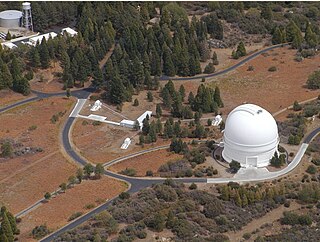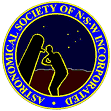 | ||||||||||||
| ||||||||||||
Howard J. Brewington (born December 3, 1952, in South Carolina) is an American comet discoverer and former professional telescope operator of the Sloan Digital Sky Survey. [1] [2]
 | ||||||||||||
| ||||||||||||
Howard J. Brewington (born December 3, 1952, in South Carolina) is an American comet discoverer and former professional telescope operator of the Sloan Digital Sky Survey. [1] [2]
As an amateur astronomer, Brewington visually discovered or co-discovered five comets while manually sweeping the night sky with his home-built reflecting telescopes. He specifically designed his telescopes for the task, which included hand-grinding and polishing the 8 and 16-inch primary mirrors himself. [3] Brewington found his first comet from South Carolina in 1989. To improve his chances of additional finds, he and his first wife, Trudy Bland-Brewington, moved to southern New Mexico in the fall of 1990 and built a comet hunting observatory on a mountain ridge east of Cloudcroft. [4] From 1991 to 1996, the relocation paid-off with four more visual discoveries. Two of his New Mexico comets, 97P/Metcalf-Brewington [5] and 154P/Brewington, [6] have short-period orbits of about ten years.
Starting in 1992, NASA-funded robotic telescopes had begun finding comets as part of their Near-Earth Object (NEO) survey. Because of this development, Brewington predicted the end of visual comet discoveries as explained in his article, “The Future Of Comet Hunting,“ which appeared in the summer 1995 issue of CCD Astronomy magazine. [7] A follow-up article by Brewington was published via Sky & Telescope magazine in November 2015, "The Last Visual Comet Hunters," which confirmed his prediction. [8]
Since NASA's automated patrol scopes left few remaining prospects for visual comet hunters, Brewington stopped comet hunting in 1999, moved back to South Carolina, and enrolled at the University of South Carolina in Columbia. He graduated with honors in the summer of 2002 and was hired by year's end as a 2.5-meter telescope operator through the Astronomy Department of New Mexico State University. From 2002 to 2015, he worked at the Apache Point Observatory in Sunspot, New Mexico, as part of the Sloan Digital Sky Survey. [9] During Sloan projects SDSS-I through SDSS-IV, Brewington collected imaging and/or spectral data for projects including First-Phase Operations, Sloan Legacy Survey, SEGUE, Sloan Supernova Survey, APOGEE, BOSS, MARVELS, SEGUE-2, APOGEE-2, eBOSS, and MaNGA.
Brewington, now retired from NMSU, lives in Bastrop, Texas, with his second wife, Maria (aka Maya) Hamby-Brewington. He is a member of the Austin Astronomical Society and often attends national star parties. Brewington’s most recent astronomical pastime is finding and imaging micrometeorites. In fact, he has found hundreds of these sub-millimeter visitors, which are created as space dust falls through Earth’s atmosphere. [10] Brewington also enjoys amateur radio. He's earned an Amateur Extra Class license, and his call sign is KJ5NJ. [11]

Amateur astronomy is a hobby where participants enjoy observing or imaging celestial objects in the sky using the unaided eye, binoculars, or telescopes. Even though scientific research may not be their primary goal, some amateur astronomers make contributions in doing citizen science, such as by monitoring variable stars, double stars, sunspots, or occultations of stars by the Moon or asteroids, or by discovering transient astronomical events, such as comets, galactic novae or supernovae in other galaxies.

Astrophotography, also known as astronomical imaging, is the photography or imaging of astronomical objects, celestial events, or areas of the night sky. The first photograph of an astronomical object was taken in 1840, but it was not until the late 19th century that advances in technology allowed for detailed stellar photography. Besides being able to record the details of extended objects such as the Moon, Sun, and planets, modern astrophotography has the ability to image objects outside of the visible spectrum of the human eye such as dim stars, nebulae, and galaxies. This is accomplished through long time exposure as both film and digital cameras can accumulate and sum photons over long periods of time or using specialized optical filters which limit the photons to a certain wavelength.

Photographic plates preceded photographic film as a capture medium in photography. The light-sensitive emulsion of silver salts was coated on a glass plate, typically thinner than common window glass. They were heavily used in the late 19th century and declined through the 20th. They were still used in some communities until the late 20th century.

Palomar Observatory is an astronomical research observatory in the Palomar Mountains of San Diego County, California, United States. It is owned and operated by the California Institute of Technology (Caltech). Research time at the observatory is granted to Caltech and its research partners, which include the Jet Propulsion Laboratory (JPL), Yale University, and the National Astronomical Observatories of China.

The Apache Point Observatory is an astronomical observatory located in the Sacramento Mountains in Sunspot, New Mexico, United States, approximately 18 miles (29 km) south of Cloudcroft. The observatory is operated by New Mexico State University (NMSU) and owned by the Astrophysical Research Consortium (ARC). Access to the telescopes and buildings is private and restricted.

Lowell Observatory Near-Earth-Object Search (LONEOS) was a project designed to discover asteroids and comets that orbit near the Earth. The project, funded by NASA, was directed by astronomer Ted Bowell of Lowell Observatory in Flagstaff, Arizona. The LONEOS project began in 1993 and ran until the end of February 2008.
Joel Hastings Metcalf was an American astronomer, humanitarian and minister.
Not to be confused with North Carolina Politician Richard Tucker

Siding Spring Observatory near Coonabarabran, New South Wales, Australia, part of the Research School of Astronomy & Astrophysics (RSAA) at the Australian National University (ANU), incorporates the Anglo-Australian Telescope along with a collection of other telescopes owned by the Australian National University, the University of New South Wales, and other institutions. The observatory is situated 1,165 metres (3,822 ft) above sea level in the Warrumbungle National Park on Mount Woorat, also known as Siding Spring Mountain. Siding Spring Observatory is owned by the Australian National University (ANU) and is part of the Mount Stromlo and Siding Spring Observatories research school.

Donald Edward Machholz was an American amateur astronomer who was credited with the discovery of 12 comets that bear his name.
The Črni Vrh Observatory is an astronomical observatory located in western Slovenia, close to the settlement of Črni Vrh, near the town of Idrija. The current observatory was built in 1985 and stands at an elevation of 730 metres (2,400 ft). Much of the construction was done by volunteers.

An astrograph is a telescope designed for the sole purpose of astrophotography. Astrographs are mostly used in wide-field astronomical surveys of the sky and for detection of objects such as asteroids, meteors, and comets.

The Astronomical Observatory of Modra, also known as Modra Observatory or the Astronomical and Geophysical observatory in Modra, is an astronomical observatory located in Modra, Slovakia. It is owned and operated by the Comenius University in Bratislava. The scientific research at the observatory is led by the Department of Astronomy, Physics of the Earth and Meteorology, Faculty of Mathematics, Physics and Informatics.
John "Jack" Borden Newton is a Canadian astronomer, best known for his publications and images in amateur astrophotography.
Paul Boltwood was a Canadian amateur astronomer. He was engaged in developing hardware and software for deep sky imaging and in research of brightness variations in active galactic nuclei. He was also acknowledged for his studies of near-nucleus activity in Comet Hyakutake.
William Ashley Bradfield was a New Zealand-born Australian amateur astronomer, notable as a prolific amateur discoverer of comets. He discovered 18 comets, all of which bear his name as the sole discoverer.

Puckett Observatory is a private astronomical observatory located in the state of Georgia. It is owned and operated by Tim Puckett. Its primary observation goals are the study of comets and the discovery of supernovae. To facilitate the latter goal it sponsors the Puckett Observatory World Supernova Search whose astronomers have discovered 369 supernovae.

The Astronomical Society of New South Wales (ASNSW) is an amateur astronomy club in the state of New South Wales, Australia, founded in 1954.
John E. Bortle is an American amateur astronomer. He is best known for creating the Bortle scale to quantify the darkness of the night sky.
Tenagra Observatory and Tenagra Observatory II are astronomical observatories in Cottage Grove, Oregon and Arizona. The observatories house heavily automated robotic telescopes.